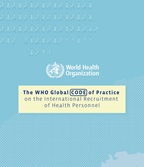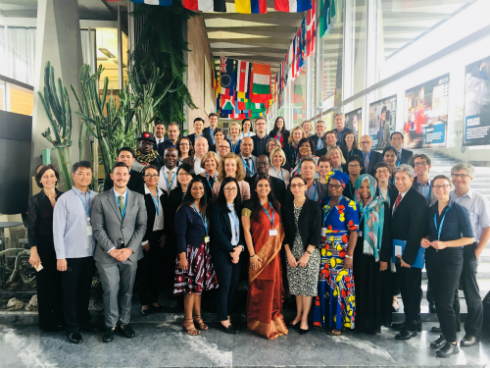
Health workers - migration
Migration
The 78th World Health Assembly considered EB156/14: Health and care workforce: WHO Global Code of Practice on the International Recruitment of Health Personnel Report by the Director-General. The Fifth round of reporting on the WHO Global Code of Practice on the International Recruitment of Health Personnel (The Code) has been completed. Regional consultations on the Expert Advisory Group’s interim report on the Code review started in June 2025.
International health worker migration is a long-standing and growing phenomenon, driven by fundamental labour market forces relating to different elements such as education, working conditions and remuneration across countries, and which has further accelerated during the COVID-19 pandemic. While substantial migration and mobility also occurs among countries in the same region or context,, increasing international recruitment from low- and middle-income countries to meet domestic shortages in high income countries can exacerbate shortages in the former. If not adequately managed, international mobility and migration of health workers from countries facing heath worker shortages can weaken their health systems and widen inequities.
To improve the governance of international health worker migration, the WHO Global Code of Practice on the International Recruitment of Health Personnel was adopted by the World Health Assembly in 2010. The Code seeks to minimize the negative consequences of health worker migration and promote workforce sustainability. The reporting on the Code implementation allows better understanding of health worker mobility trends and highlight priority issues that warrant attention.
The recommendations of the Global Code of Practice on the International Recruitment of Health Personnel and the associated WHO health workforce support and safeguards list 2023 link international health worker migration with investments in health system strengthening in all countries. Well managed health worker migration can advance health worker welfare and benefits to health systems in both source and destination countries and contribute to progress towards Sustainable Development Goals on health, gender equality, decent working conditions and economic growth and reducing inequalities.
Support & safeguard
Q&A
New publication
EB156/14: Health and care workforce: WHO Global Code of Practice on the International Recruitment of Health Personnel Report by the Director-General
Events
Reporting instruments
2024 National Reporting Instrument on the WHO Global Code of Practice on the International Recruitment of Health Personnel
2024 Private recruitment agencies reporting instrument on the WHO Global Code of Practice on the International Recruitment of Health Personnel
2024 Independent Stakeholders Reporting Instrument on the WHO Global Code of Practice on the International Recruitment of Health Personnel
WHO Code of Practice
Managing health workforce migration - the Global Code of Practice
The WHO Global Code of Practice on the International Recruitment of Health Personnel (The Code), adopted by the World Health Assembly in 2010, is a key global governance instrument. It is contributing to better understanding and management of health worker migration through improved data, information and cooperation. Member States and all relevant stakeholders are called upon to implement and repoort on the recommendations of the Code, with the WHO Director-General mandated to report on its implementation every three years. More on monitoring implementation

The WHO Global Code of Practice on the International Recruitment of Health Personnel, approved by Member States in the Sixty-third World Health Assembly...

User’s Guide to the WHO Global Code of Practice on the International Recruitment of Health Personnel
Reaching the health-related Millennium Development Goals will be impossible without strong and adequately staffed national health systems. Nevertheless,...

Third round of national reporting: WHO Global Code of Practice on the International Recruitment of Health...
The Executive Board, at its 144th session in January 2019, noted an earlier version of this report. The report has been updated to reflect the situation...
International platform – mobility
The international migration of health workers is increasing. Over the last decade, the number of migrant doctors and nurses within OECD countries has increased by 60%. Future projections in economic demand and supply of health workers point to a continuing acceleration in the international migration of health workers.
Patterns of health worker mobility are also growing increasingly complex. There is growing evidence of substantial intraregional, South–South, and North–South movement, to complement better understood movement from the Global South to the Global North. Temporary migration, as well as registration and employment in multiple jurisdictions, is also becoming common. Health professional education has itself globalized, with increasing scale and complexity of student movement. More effective management of human mobility has risen to the top of the international agenda.
The Global Strategy on Human Resources for Health: Workforce 2030 and the report of the High Level Commission on Health Employment and Economic Growth (“Commission Report”), Working for Health and Growth, further evidences the desire from states and policy-makers to specifically understand and address health worker mobility flows, with a view to maximize benefits from such movement through multi-stakeholder dialogue and international cooperation.
The Commission report, while calling for countries to do more to achieve greater self-sufficiency and sustainability in domestic supply, emphasizes that the international mobility of health workers, if appropriately governed and adverse effects addressed, can deliver numerous benefits. As an immediate action therefore , the Commission calls on ILO, OECD, and WHO to work with relevant partners to establish an international platform on health worker mobility to advance dialogue, knowledge and cooperation in the area.
Vision - To maximize the benefits and mitigate adverse effects from health labour mobility through elevated dialogue, knowledge, and cooperation.
Objective - To facilitate robust policy dialogue and action on health labour mobility through strengthened monitoring, country support, knowledge generation and sharing, and through strengthened support to implementation of the WHO Global Code and relevant ILO Conventions and Recommendations.
Tools, guidelines and publications
WHO Global Code of Practice: National Reporting Instrument 2021
Expert Advisory Group’s 2nd Review of Code Relevance and Effectiveness
Report of the WHO Expert Advisory Group on the Relevance and Effectiveness of the WHO Global Code of Practice on the International Recruitment of Health Personnel
WHO Global Code of Practice: an overview
Third round of national reporting: WHO Global Code of Practice on the International Recruitment of Health Personnel
Second round of reporting: WHO Global Code of Practice on the International Recruitment of Health Personnel
User’s Guide to the WHO Global Code of Practice on the International Recruitment of Health Personnel
WHO Global Code of Practice on the International Recruitment of Health Personnel
Multimedia
Resolutions
Related documents
Related links



